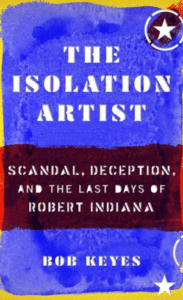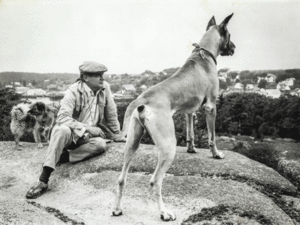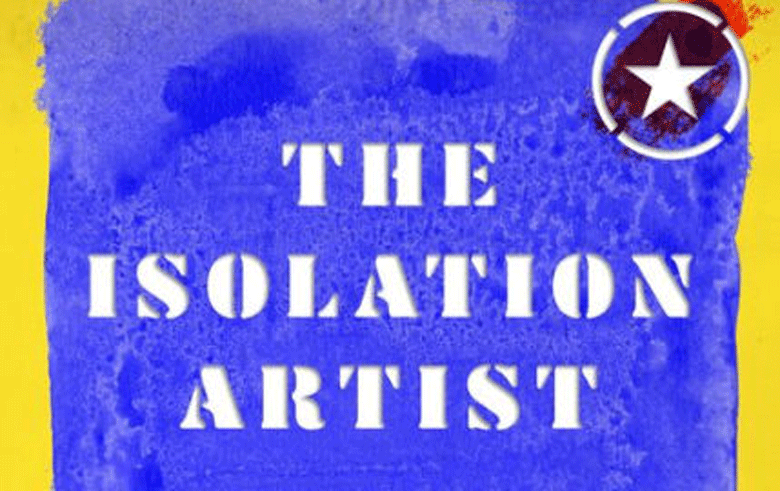The Isolation Artist: Scandal, Deception, and the Last Days of Robert Indiana
By Bob Keyes
Born Robert Earl Clark in Newcastle, Indiana, in 1928, the famed “Love” artist changed his name in 1958 not long after moving to New York City—a way to pay homage to his home state, but also to help make him stand out in the art scene. And that he did: at his death in 2018, Robert Indiana held a firm spot in the art-historical continuum. The “sign painter” Pop artist had achieved international fame for his paintings, prints, and sculpture.

After reading art writer Bob Keyes’s engrossing The Isolation Artist: Scandal, Deception, and the Last Days of Robert Indiana, you can understand why he didn’t change his name to Robert Maine. Despite spending the better part of 40 years of his life on Vinalhaven, Indiana never really got along with his adopted state. Whether being shunned by fellow islanders for alleged sexual predation, having his “7” sculpture vandalized (twice) in front of the Portland Museum of Art, or suffering the slights he imagined Maine museum directors gave him, Indiana was an unhappy camper—even though his camp was the castle-like Victorian-era Star of Hope Lodge, a former Odd Fellows Hall on the Penobscot Bay island.
Despite spending the better part of 40 years of his life on Vinalhaven, Indiana never really got along with his adopted state.
Much of the book recounts the wrangling over rights to market, reproduce, and sell Indiana’s work. It’s a sad and often grim and ugly tale of art world corruption and back-stabbing, of opportunistic vultures circling a belligerent yet vulnerable cash cow. The thumbnail bios of “The Players” at the end of the book come in handy.
At times the book reads like a police procedural—cooked books, tampering with evidence, questions about the artist’s living conditions, even foul play: Indiana’s body was briskly removed from the island just days after a lawsuit had been filed against him by the Morgan Art Foundation for breach of contract.
Unlike, say, the famous Brooke Astor case, which also had its share of twists and turns—and accusations of elder abuse—there were few high-profile friends and/or celebrities to question Indiana’s treatment. That said, the artist had his champions, among them, art historian John Wilmerding, who wrote or co-wrote several books on the artist, including The Essential Robert Indiana (2013). As someone who knew the work intimately, Wilmerding smelled forgery in some of the later work, including a series that featured Bob Dylan lyrics, but he also recognized that Indiana “was his own undoing.”

A number of islanders make cameo appearances, including poet, painter, and theater producer/director John Wulp, who maintained a cantankerous relationship with Indiana, and Jennifer Desmond, clinical director of the Island Community Medical Services, who signed the artist’s death certificate. Indiana was a Christian Scientist and, according to Desmond, “did not love Western medicine,” which helps explain his physical deterioration over his final years.
Keyes started covering Indiana in 2002, not long after he joined the Portland Press Herald/Maine Sunday Telegram staff. He stuck with the story, right up to and after the artist’s death. He admired Indiana, as he notes in an afterword, but also considered him an ass.
The Indiana saga continues to play out in the courts and press. In late May the Associated Press reported that the Maine attorney general’s office was demanding that law firms in Maine and New York return millions of dollars allegedly overpaid by Indiana’s estate. Then in early June Keyes broke the story in the Press Herald that allegations that Indiana paid teenagers on Vinalhaven for sex in the 1980s had resurfaced.
The U.S. Postal Service recently released its latest iteration of its “Love” stamp, a series started in 1973 with Indiana’s famous design (he was paid a $1,000 fee). There is enormous irony that the artist best known for his interpretations of that four-letter word ended up for the most part unloved. Indiana’s story is, in Keyes’s words, “a tragedy of Shakespearean machinations,” but it is also a tale of ego, eccentricity, and enmity. You’ll be shaking your head by the end.
The Farnsworth Art Museum in Rockland is currently showing “Robert Indiana: The Hartley Elegies,” 10 large-scale silkscreen prints from the series made between 1989 and 1994. The show runs through Jan. 2.
Carl Little writes about art for several publications, including Maine Boats, Homes & Harbors. He lives on Mount Desert Island.





